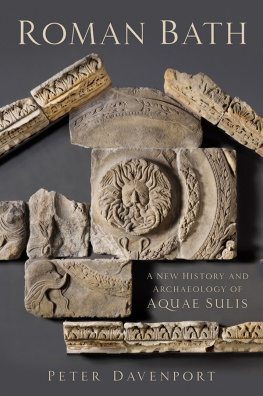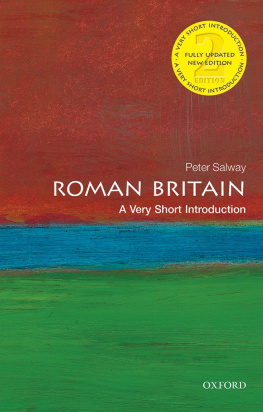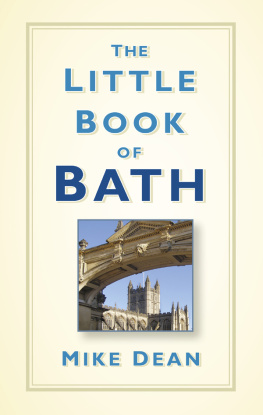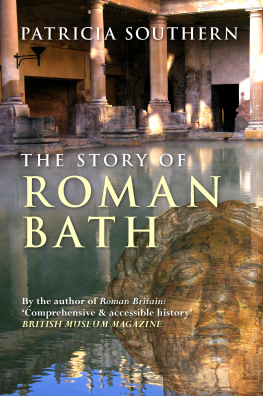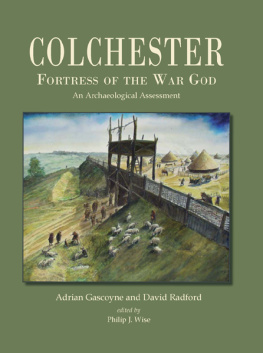Contents
Guide

To Lisa, Sarah and Becca
and in memory of
John C. Clarke, amicus romanorum
First published 2021
The History Press
The Mill, Brimscombe Port
Stroud, Gloucestershire, GL5 2QG
www.thehistorypress.co.uk
Peter Davenport, 2021
The right of Peter Davenport to be identified as the Author of this work has been asserted in accordance with the Copyright, Designs and Patents Act 1988.
All rights reserved. No part of this book may be reprinted or reproduced or utilised in any form or by any electronic, mechanical or other means, now known or hereafter invented, including photocopying and recording, or in any information storage or retrieval system, without the permission in writing from the Publishers.
British Library Cataloguing in Publication Data.
A catalogue record for this book is available from the British Library.
ISBN 978 0 7509 9643 3
Typesetting and origination by Typoglyphix, Burton-on-Trent
Printed in Great Britain by TJ International Ltd, Padstow, Cornwall
eBook converted by Geethik Technologies
CONTENTS
Index
ACKNOWLEDGEMENTS
I would first like to thank Stephen Clews, whose title of Roman Baths and Pump Room Manager does not do justice to his academic knowledge and interest in the archaeology of the Roman Baths. He asked if I would write a new and up-to-date survey of the Roman town that owed its existence to the baths and spring. His colleagues at the museum have been unfailingly helpful, especially Susan Fox, collections manager and her assistant, Zofia Matyjaskiewicz, in providing access to the museums archaeological archives and images and providing new ones. I must also thank my colleagues at the former Bath Archaeological Trust, especially Mark Beaton, Robert Bell and Marek Lewcun, who ran or supervised nearly all the archaeological investigations in the town between 1983 and 2005. Marek has also been involved in most of the work since that latter date and has helped fill in gaps in the visual record with images he had taken.
Photographs and other images are individually credited, except as follows, and with the exception of is copyright West Air Photography, now part of the Historic England Archive. As the archive has been completely closed during the Covid-19 pandemic, it has not been possible to formally acquire permission. The situation will be regularised as soon as it becomes possible to do so.
My wife, Lisa Brown, acted as proofreader and added what elegance there might be to the text. Finally, I have to acknowledge Emeritus Professor Sir Barry Cunliffe, who brought his ex-student to Bath all those years ago and generously provided the foreword to this edition.
LIST OF ILLUSTRATIONS
Chapter 1
Flints from the Hot Bath spring. (Roman Baths Museum)
The hot springs as they may have looked before the Romans came (actually a spring in Armenia).
).
Celtic coins from the spring. ( Bath and North East Somerset Council, Roman Baths Museum)
).
).
The Dobunni and their neighbours.
Roman roads and the Avon Valley topography around Aquae Sulis.
Bath, sitting in the Avon Valley, looking south-west from Solsbury Hill. The valley continues towards the Severn on the right.
The Fosse Way road surfaces and roadside ditch exposed at Hat and Feather Yard. (Marek Lewcun)
Chapter 2
The tombstone of cavalry trooper Lucius Vitellius Tancinus. (Roman Baths Museum)
The octagonal building at Hat and Feather Yard. It has been cut into the hillside and then cut away itself on the left by a later building. (Marek Lewcun)
Early, probably pre-AD 69, pottery from Nelson Place and Hat and Feather Yard. Locally made, military-type flagons and a honey pot and a complete example of one of the imported amphora types found at Walcot (here from Verulamium, Verulamium Museum), common on military sites, usually containing olives or olive pressings.
The early road junction at Walcot and the octagonal building.
Excavations at Bathwick, one of the early Roman, probably military ovens. (Marek Lewcun)
Early, typically military, glass and pottery from Nelson Place. ( Bath and North East Somerset Council, Roman Baths Museum)
Chapter 3
).
Coins of Nero from spring. ( Bath and North East Somerset Council, Roman Baths Museum)
The spring under construction. ( Bath and North East Somerset Council, Roman Baths Museum)
Oak piles in the spring and wall during the 1979 dig. ( Barry Cunliffe/Oxford University School of Archaeology)
Sluices from the baths and possibly of the sacred spring. ( Bath and North East Somerset Council, Roman Baths Museum)
The baths and temple as first built, around AD 70.
The south wall of the spring and the West Bath windows. ( Barry Cunliffe/Oxford University School of Archaeology)
The lead lining of the sacred spring tank in 1878. ( The Society of Antiquaries of London)
The sculptured pediment of the temple, coloured as it might have been.
Close-up photo of the Gorgon in its roundel. ( Bath and North East Somerset Council, Roman Baths Museum)
Chapter 4
Plan of the Period 1 baths.
Photo of the Great Bath drained. ( Bath and North East Somerset Council, Roman Baths Museum)
Hoares depiction of the East Baths in 1754. ( The British Library Board [Add. MS 21577b])
with modifications).
Reconstruction of interior of the Period 1 Great Bath.
).
Reconstruction of the temple precinct in the late period. ( Bath and North East Somerset Council, Roman Baths Museum)
Four of the deities on the altar corners, clockwise from top left: Bacchus, Hercules, Apollo and Jupiter. ( Bath and North East Somerset Council, Roman Baths Museum)
Minervas head. ( Bath and North East Somerset Council, Roman Baths Museum)
The Vilbia curse and coins from the sacred spring. ( Bath and North East Somerset Council, Roman Baths Museum)
Personal items, bracelets, earrings and brooches, and the ivory handle from a folding blade, probably a cosmetic implement (70mm long) all from the sacred spring. ( Bath and North East Somerset Council, Roman Baths Museum)
The ballista washer (83mm diameter) and gemstones from the sacred spring and the culvert. The gems are typically 10 12.5mm. (washer Bath and North East Somerset Council, Roman Baths Museum and the gems from Cunliffe 2000, Pl. 23)
The tin mask from the drain (330mm high) and the ivory breast ex-voto (70mm across) from the sacred spring. ( Bath and North East Somerset Council, Roman Baths Museum)
Pewter vessels from the sacred spring and culvert. ( Bath and North East Somerset Council, Roman Baths Museum)
Paterae from the sacred spring, all inscribed Deae Sulis Minervae or variations. The bronze patera is the probable Hadrians Wall souvenir. ( Bath and North East Somerset Council, Roman Baths Museum)
).
Fragments of probable priests regalia from the sacred spring ( Bath and North East Somerset Council, Roman Baths Museum) and a reconstruction of the filigree as hat decoration.
A selection of items from the sacred spring. ( Bath and North East Somerset Council, Roman Baths Museum)
The penannular brooch from the sacred spring: probably late fifth century. ( Bath and North East Somerset Council, Roman Baths Museum)
Chapter 5

